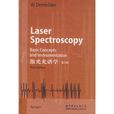基本信息
作 者:(德)德姆特勒德(Demtroder,W.) 著
出 版 社:世界圖書出版公司
出版時間:2008-8-1
版 次:1
頁 數:987
字 數:
印刷時間:2008-8-1
開 本:24開
紙 張:膠版紙
印 次:1
I S B N:9787506291880
包 裝:精裝
內容簡介
《雷射光譜學》選題豐富,闡述清楚深刻,注重實際套用,已經成為一本經典的雷射光譜學研究生教材和參考用書。此次影印的是最新的第三版。在前兩版的基礎上,作者做了全面的修訂和增補,介紹了雷射光譜學最新的實驗技術和理論進展,例如:外腔中的倍頻,可調控的窄帶紫外光源,更靈敏的檢測技術,可調諧飛秒和分飛秒雷射器(X光區域和阿秒範圍),可控原子分子激發,相干物質波,還有更多在化學分析,醫療診斷和工程等方面的套用。適合從事雷射光譜學研究的物理學家和化學物理學家以及眾多的工程人員學習和參考。
《雷射光譜學》特色:(1)內容非常豐富,涵蓋了雷射光譜學中眾多分支,並附有全面的參考文獻。(2)把重要的概念和公式用框線括起來,方便讀者查閱。
讀者對象:適用於物理,化學和材料專業的高年級本科生、研究生和相關專業的科研人員和工程師。
目次:簡介;光的吸收和發散;非線性光譜;雷射拉曼光譜;束中的雷射光譜;光泵譜和雙共振技術;時間分辨的雷射光譜;相干光譜;碰撞過程中的雷射光譜;雷射光譜新進展;雷射光譜的套用;參考文獻;主題索引。
作者簡介
德姆特勒德,德國凱澤斯勞滕大學教授,著名雷射光譜學專家。創建了高解析度雷射光譜技術及其在原子分子理學中的套用這一研究領域。1995年獲得由德國物理學會和物理研究所頒發的馬克思—博恩獎。2000年獲得洪堡基金會頒發的海森堡獎。
目錄
1.Introduction
2.Absorption and Emission of Light
2.1 Cavity Modes
2.2 Thermal Radiation and Planck's Law
2.3 Absorption, Induced, and Spontaneous Emission
2.4 Basic Photometric Quantities
2.5 Polarization of Light
2.6 Absorption and Emission Spectra
2.7 Transition Probabilities
2.8 Coherence Properties of Radiation Fields
2.9 Coherence of Atomic Systems
Problems
3.Widths and Profiles of Spectral Lines
3.1 Natural Linewidth
3.2 Doppler Width
3.3 Collisional Broadening of Spectral Lines
3.4 Transit-Time Broadening
3.5 Homogeneous and Inhomogeneous Line Broadening
3.6 Saturation and Power Broadening
3.7 Spectral Line Profiles in Liquids and Solids
Problems
4.Spectroscopic Instrumentation
4.1 Spectrographs and Monochromators
4.2 Interferometers
4.3 Comparison Between Spectrometers and Interferometers
4.4 Accurate Wavelength Measurements
4.5 Detection of Light
4.6 Conclusions
Problems
5.Lasers as Spectroscopic Light Sources
5.1 Fundamentals of Lasers
5.2 Laser Resonators
5.3 Spectral Characteristics of Laser Emission
5.4 Experimental Realization of Single-Mode Lasers
5.5 Controlled Wavelength Tuning of Single-Mode Lasers
5.6 Linewidths of Single-Mode Lasers
5.7 Tunable Lasers
5.8 Nonlinear Optical Mixing Techniques
5.9 Gaussian Beams
Problems
6.Doppler-Limited Absorption and Fluorescence Spectroscopy with Lasers
6.1 Advantages of Lasers in Spectroscopy
6.2 High-Sensitivity Methods of Absorption Spectroscopy
6.3 Direct Determination of Absorbed Photons
6.4 Ionization Spectroscopy
6.5 Optogalvanic Spectroscopy
6.6 Velocity-Modulation Spectroscopy
6.7 Laser Magnetic Resonance and Stark Spectroscopy
6.8 Laser-Induced Fluorescence
6.9 Comparison Between the Different Methods
Problems
7.Nonlinear Spectroscopy
7.1 Linear and Nonlinear Absorption
7.2 Saturation of Inhomogeneous Line Profiles
7.3 Saturation Spectroscopy
7.4 Polarization Spectroscopy
7.5 Multiphoton Spectroscopy
7.6 Special Techniques of Nonlinear Spectroscopy
7.7 Conclusion
Problems
8.Laser Raman Spectroscopy
8.1 Basic Considerations
8.2 Experimental Techniques of Linear Laser Saman Spectroscopy
8.3 Nonlinear Raman Spectroscopy
8.4 Special Techniques
8.5 Applications of Laser Raman Spectroscopy
Problems
9.Laser Spectroscopy in Molecular Beams
9.1 Reduction of Doppler Width
9.2 Adiabatic Cooling in Supersonic Beams
9.3 Formation and Spectroscopy of Clusters and Van der Waals Molecules in Cold Molecular Beams
9.4 Nonlinear Spectroscopy in Molecular Beams
9.5 Laser Spectroscopy in Fast Ion Beams
9.6 Applications of FIBLAS
9.7 Spectroscopy in Cold Ion Beams
9.8 Combination of Molecular Beam Laser Spectroscopy and Mass Spectrometry
Problems
10.Optical Pumping and Double-Resonance Techniques
10.1 Optical Pumping
10.2 Optical-RF Double-Resonance Technique
10.3 Optical-Microwave Double Resonance
10.4 Optical-Optical Double Resonance
10.5 Special Detection Schemes of Double-Resonance Spectroscopy
Problems
11.Time-Resolved Laser Spectroscopy
11.1 Generation of Short Laser Pulses
11.2 Measurement of Ultrashort Pulses
11.3 Lifetime Measurement with Lasers
11.4 Pump-and-Probe Technique
Problems
12.Coherent Spectroscopy
12.1 Level-Crossing Spectroscopy
12.2 Quantum-Beat Spectroscopy
12.3 Excitation and Detection of Wave Packets in Atoms and Molecules
12.4 Optical Pulse-Train Interference Spectroscopy
12.5 Photon Echoes
12.6 Optical Nutation and Free-Induction Decay
12.7 Heterodyne Spectroscopy
12.8 Correlation Spectroscopy
Problems
13.Laser Spectroscopy of Collision Processes
13.1 High-Resolution Laser Spectroscopy of Collisional Line Broadening and Line Shifts
13.2 Measurements of Inelastic Collision Cross Sections of Excited Atoms and Molecules
13.3 Spectroscopic Techniques for Measuring Collision-Induced Transitions in the Electronic Ground State of Molecules
13.4 Spectroscopy of Reactive Collisions
13.5 Spectroscopic Determination of Differential Collision Cross Sections in Crossed Molecular Beams
13.6 Photon-Assisted Collisional Energy Transfer
13.7 Photoassociation Spectroscopy of Colliding Atoms
Problems
14.New Developments in Laser Spectroscopy
14.1 Optical Cooling and Trapping of Atoms
14.2 Spectroscopy of Single Ions
14.3 Optical Ramsey-Fringes
14.4 Atom Interferometry
14.5 The One-Atom Maser
14.6 Spectral Resolution Within the Natural Linewidth
14.7 Absolute optical Frequency Measurement and Optical Frequency Standards
14.8 Squeezing
15.Applications of Laser Spectroscopy
15.1 Applications in Chemistry
15.2 Environmental Research with Lasers
15.3 Applications to Technical Problems
15.4 Applications in Biology
15.5 Medical Applications of Laser Spectroscopy
15.6 Concluding Remarks
References
Subject Index

